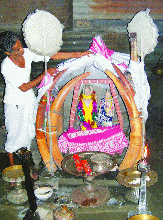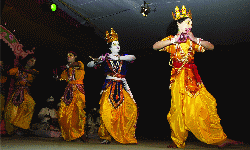Ode to Majuli

Ode to Majuli
It’s a case of so near but yet so far. Majuli, the world’s largest inhabited riverine island and the seat of Vaishnavite culture, again failed to find a place in the World Heritage Site list of UNESCO much to the chagrin of the residents of the river island fighting with their backs against all odds against the fury of floods and erosion caused by the Brahmaputra river almost every year. Sensing all-round despair and despondency, Prime Minister Dr. Manmohan Singh, who represents Assam in the Rajya Sabha tried to apply the soothing balm when he visited Jorhat last year. He vowed to protect Majuli both geographically and culturally at any cost.
Singh met the 24 satradhikars (heads of Vaishnavite monasteries) who also have pitched in their efforts to save the island from being gobbled up by the mighty Brahmaputra, and assured them that ‘funds will not be a constraint’ and the Government would do all that was required to get the World Heritage Site tag for the island.
The head priests who are spearheading the movement ‘Save Majuli’ are demanding scientific surveys by technical experts and a long-term plan for the protection of the island besides construction of a national highway from Kamalabari ghat in Majuli to north Lakhimpur town.
Also unleashing the campaign for protecting the island from the fury of the Brahmaputra is Dr Arun Kumar Sarma, Member of Parliament from the state, who is also the chairman of the Majuli Island Protection and Development Council (MIPDC). The MIPDC, which has been campaigning for Majuli’s recognition as a World Heritage Site since 1995, has documented the rich natural and cultural heritage of the river island, which includes 69 photographs and two satellite imageries.
A team of experts from the Directorate of National Archives visited the river island to preserve in microfilm the various facets of Majuli, including the Vaishnavite satras (monasteries) dating back to the 16th century.
Mr. Bruce E. Jefferies, a Protected Area Management Specialist and a member of the World Protected Areas Commission of the IUCN visited the island to study the prevailing situation in connection with the proposed nomination of the island as a World Heritage Site. In his report to the UNESCO and the World Heritage Committee, Jefferies observed, the history of the cultural and religious aspects of Majuli are, unlike its biodiversity value - which would need surveys, spread  over a range of sessions - “without doubt significant, as, some of the most important monasteries of the Sankardev’s faith (called satras), built sometime in the 15th century, still exist.
over a range of sessions - “without doubt significant, as, some of the most important monasteries of the Sankardev’s faith (called satras), built sometime in the 15th century, still exist.
“The satras house valuable manuscripts and are living embodiments of Vaishnav culture which appears to be very well preserved in the form of dance, song, chants and music (bhaona, ankiya, raasleela, etc).”
Jefferies suggested UNESCO to consider asking the IUCN to conduct a feasibility assessment aimed at integrating the World Heritage nomination with the establishment of protected area management principles and objectives - as provided by the IUCN Category 5 - Protected Landscapes.
Meanwhile, the World Heritage Committee of UNESCO in its 32nd session in Quebec, Canada had asked the Centre to gather more information on the satras in Majuli island.
The International Council of Monuments and Sites (ICOMOS), a non-governmental association of professionals dedicated to conservation and protection of the world’s historical and cultural heritage sites, has blamed the State Government for failing to highlight the riverine island’s “Outstanding Universal Value” (OUV), a prerequisite for getting the World Heritage recognition. An ICOMOS evaluation mission will soon visit the island to make an assessment of the extent and scope of the satras on the landscape of Majuli.
Interestingly, ICOMOS in its report to the World Heritage Committee said Majuli as a whole can not be considered a World Heritage Site but only a selection of satras could be examined for the coveted tag.
“The satras of Majuli can be seen as exceptional testimony to the Vaishnava cultural tradition that brought disparate peoples together through cultural practices. However, as the influence does not manifest itself across the cultural landscape of Majuli, ICOMOS does not consider that this criterion can be applied to the whole island, but might apply to the satras as a group or to a selection of the satras,” the report said.Majuli with its sublime and serene atmosphere provided the backdrop for the historic “Moni kanchan sanjog” between Assam’s pioneer Vaishnavite saint Srimanta Sankaradeva and his famous disciple Madhabdeva in  the 15th century. Ever since that meeting of the great minds and the subsequent establishment of satras that followed, Majuli emerged as the crowning glory of Vaishnavite culture in Assam.
the 15th century. Ever since that meeting of the great minds and the subsequent establishment of satras that followed, Majuli emerged as the crowning glory of Vaishnavite culture in Assam.
These monasteries, the treasure house of Satriya culture and home to the Satriya dance and traditional Bhaona (mask) theatre, today face the fury of perennial floods and heavy soil erosion. There were 65 such monasteries, but only 31 of them have so far managed to withstand nature’s fury. But even their survival is at stake. While the pressure on land has increased tremendously, with the population increasing from 35,000 in 1901 to 1,35,378 in 1991, the island’s total area has shrunk from around 2,82,165 acres (according to a report of J.H. Mills in 1853) to hardly about 886 sq. km due to unabated erosion caused by the Brahmaputra river.
Infrastructural facility has been hit hard by recurring floods. The embankments form the present road network; any breach in the embankments disrupts communication as last year’s unprecedented deluge submerged 190 of the total 243 villages affecting 1.7 lakh people.
It is against this gloomy backdrop that Assam Chief Minister Tarun Gogoi has prevailed upon Prime Minister Dr. Manmohan Singh to release Rs.40 crore from the Centre to carry out anti-erosion measures and for rehabilitation of the flood-hit people. Gogoi has also announced Rs.100 crore from the State Government to Majuli for anti-erosion measures. Gogoi has asked Jorhat district officials to make an action plan for flood management in Majuli with expertise from Dibrugarh University, IIT Guwahati and experts from outside Assam.
As things stand today, Majuli’s hope hinges, as succinctly put by Dhiren Bora of Kahargaon, a nondescript village in the riverine island: “Recognition from the world body coupled with assistance from the State and Central Governments can only save Majuli and us from being swallowed by the Brahmaputra river.”


